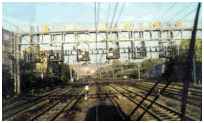|
|
|
|
|
|
|
|
|
|
|

 Great Western Trains  Railtrack  Health & Safety Executive  Metropolitan Police  British Transport Police 
 Green for Danger - The Phantom signal by Ray State  Beware the Paddington witch hunt This Is London - 13 Oct 99 
 Seven days . . . . . . web focus on rail safety and accidents in the last week |
||||
Paddington Rail Tragedy - Crash train driver may have thought signal was green: Thursday, October 14, 1999The driver of the Thames Trains "Turbo" train which collided with a GWT IC 125 killing at least 30 people last
Data from the black box recorder recovered from the crash scene shows that he had correctly slowed slowed down at the previous yellow signal but as he approached signal SN109, he accelerated to 45mph. The data shows that he did not begin to slow down again until just moments before the impact. A full brake application was made but did little to slow the train. Accident investigators believe that it is possible that the strong sunlight, reflecting off the optical system of the signal may have convinced the driver that the light was green. Because of the acceleration of the train from the signal, the driver is unlikely to have thought that the signal displayed a yellow aspect. A yellow light informs the driver that the next signal could be red. Such false indications from colour light signals are not unknown. A 1997 accident in the USA at Hummelstown, Pennsylvania was caused in just such circumstances. After extensive testing, the US NTSB showed that a signal which was displaying red could be misread by train crews due to the sun reflecting off it. The phenomenon is known as a "phantom signal". A 1975 accident in South London was blamed on the effect of low sun on the signal aspect.
|
|
|
